Germination-Induced Biofortification: Improving Nutritional Efficacy, Physicochemical Properties, and In Vitro Digestibility of Black Rice Flour
Abstract
1. Introduction
2. Materials and Methods
2.1. Material and Chemicals
2.2. Preparation of Germinated Black Rice Flour (GBRF)
2.3. Analysis of Nutrition Components
2.3.1. Amylose Starch and Reducing Sugar
2.3.2. Free Amino Acid and GABA
2.3.3. Mineral Profiles
2.4. Measurement of α-Amylase Activity
2.5. Water Absorption Index (WAI) and Water Solubility Index (WSI)
2.6. Differential Scanning Calorimetry (DSC) Analysis
2.7. Rapid Visco Analyzer (RVA) Analysis
2.8. In Vitro Digestibility Test
2.9. Analysis Methods of Structural Properties
2.9.1. Scanning Electron Microscopy (SEM)
2.9.2. Fourier Transform Infrared Spectroscopy (FTIR)
2.9.3. X-Ray Diffraction (XRD)
2.10. Statistical Analysis
3. Results and Discussion
3.1. The Effect of Germination on the Apparent and Microscopic Characteristics of BRF
3.2. The Effect of Germination on Nutritional Profiles of BRF
3.2.1. Changes of Apparent Amylose and Reducing Sugar During Germination
3.2.2. Changes of Free Amino Acid and GABA During Germination
3.2.3. Changes of Minerals During Germination
3.3. The Effect of Germination on the Physicochemical Properties of BRF
3.4. The Effect of Germination on the Thermal Properties of BRF
3.5. The Effect of Germination on the Pasting Properties of BRF
3.6. The Effect of Germination on In Vitro Digestibility of BRF
3.7. XRD
3.8. FTIR
4. Conclusions
Author Contributions
Funding
Data Availability Statement
Conflicts of Interest
References
- Kraithong, S.; Liu, Y.H.; Suwanangul, S.; Sangsawad, P.; Theppawong, A.; Bunyameen, A. A comprehensive review of the impact of anthocyanins from purple/black rice on starch and protein digestibility, gut microbiota modulation, and their applications in food products. Food Chem. 2025, 473, 143007. [Google Scholar] [CrossRef]
- Ito, V.C.; Lacerda, L.G. Black rice (Oryza sativa L.): A review of its historical aspects, chemical composition, nutritional and functional properties, and applications and processing technologies. Food Chem. 2019, 301, 125304. [Google Scholar] [CrossRef]
- Obadi, M.; Xu, B. Effect of processing methods and storage on the bioactive compounds of black rice (Oryza sativa L.): A review. Food Funct. 2023, 14, 9100–9122. [Google Scholar] [CrossRef]
- Ye, S.X.; Qin, J.B.; Zongo, A.W.; Li, J.; Liang, H.S.; Li, B. Physicochemical properties, phenolic content and in vitro digestion profile of Chinese black rice (Oryza sativa L.). Food Funct. 2023, 14, 9767–9781. [Google Scholar] [CrossRef]
- Leonarski, E.; Kuasnei, M.; Cesca, K.; Oliveira, D.D.; Zielinski, A. Black rice and its by-products: Anthocyanin-rich extracts and their biological potential. Crit. Rev. Food Sci. 2024, 64, 9261–9279. [Google Scholar] [CrossRef]
- Chaiyasut, C.; Sivamaruthi, B.S.; Pengkumsri, N.; Keapai, W.; Kesika, P.; Saelee, M.; Tojing, P.; Sirilun, S.; Chaiyasut, K.; Peerajan, S.; et al. Germinated Thai black rice extract protects experimental diabetic rats from oxidative stress and other diabetes-related consequences. Pharmaceuticals 2016, 10, 3. [Google Scholar] [CrossRef]
- Liu, X.Y.; Guo, Y.B.; Wang, S.C.; Wang, X.Y.; Wang, Z.H.; Wang, Z. Effects of ultrasound combined with hydrothermal treatment on the quality of brown rice. LWT 2024, 196, 115874. [Google Scholar] [CrossRef]
- Li, H.Y.; Fitzgerald, M.A.; Prakash, S.; Nicholson, T.M.; Gilbert, R.G. The molecular structural features controlling stickiness in cooked rice, a major palatability determinant. Sci. Rep. 2017, 7, 43713. [Google Scholar] [CrossRef] [PubMed]
- Zhu, C.; Lin, Z.H.; Jiang, H.B.; Wei, F.F.; Wu, Y.; Song, L.H. Recent advances in the health benefits of phenolic acids in whole grains and the impact of processing techniques on phenolic acids: A comprehensive review. J. Agric. Food Chem. 2024, 72, 24131–24157. [Google Scholar] [CrossRef] [PubMed]
- Liu, L.P.; Jiang, X.; Chen, Y.L.X.; Yaqoob, S.; Xiu, L.; Liu, H.M.; Zheng, M.Z.; Cai, D.; Liu, J.S. Germination-induced modifications of starch structure, flour-processing characteristics, and in vitro digestive properties in maize. Food Chem. X 2024, 22, 101430. [Google Scholar] [CrossRef] [PubMed]
- Lu, W.C.; Cheng, Y.T.; Chan, Y.J.; Yan, J.; Li, P.H. Effects of different soaking and germinating conditions on γ-aminobutyric acid, antioxidant activity, and chemical composition of djulis (Chenopodium formosanum). J. Agric. Food Res. 2024, 17, 101162. [Google Scholar] [CrossRef]
- Yu, Z.H.; Gao, Y.; Duan, H.L.; Zheng, D.; Shang, Z.Q.; Zhang, L.X.; Chen, Y.S. Ultrasound-assisted germination of red kidney beans: Enhancements in physicochemical and nutritional profiles. Food Chem. 2024, 454, 139829. [Google Scholar] [CrossRef]
- Tufail, T.; Ain, H.B.U.; Virk, M.S.; Ashraf, J.; Ahmed, Z.; Khalil, A.A.; Rasheed, A.; Xu, B. GABA (γ-aminobutyric acid) enrichment and detection methods in cereals: Unlocking sustainable health benefits. Food Chem. 2025, 464, 141750. [Google Scholar] [CrossRef]
- Liu, X.L.; Zhang, J.; Yang, X.J.; Sun, J.W.; Zhang, Y.Y.; Su, D.M.; Zhang, H.; Wang, H.W. Combined molecular and supramolecular structural insights into pasting behaviors of starches isolated from native and germinated waxy brown rice. Carbohydr. Polym. 2022, 283, 119148. [Google Scholar] [CrossRef] [PubMed]
- Luo, X.Y.; Li, D.D.; Tao, Y.; Wang, P.; Yang, R.Q.; Han, Y.B. Effect of static magnetic field treatment on the germination of brown rice: Changes in α-amylase activity and structural and functional properties in starch. Food Chem. 2022, 383, 132392. [Google Scholar] [CrossRef]
- Baranzelli, J.; Kringel, D.H.; Colussi, R.; Paiva, F.F.; Aranha, B.C.; Miranda, M.Z.D.; Zavareze, E.D.R.; Dias, A.R.G. Changes in enzymatic activity, technological quality and gamma-aminobutyric acid (GABA) content of wheat flour as affected by germination. LWT 2018, 90, 483–490. [Google Scholar] [CrossRef]
- Chen, B.J.; Wang, X.; Liu, H.R.; Zhang, Y.; Wu, S.H.; Wang, C.F.; Liu, C.X.; Qiao, Y.J. Effect of ultrasound-assisted enzyme pretreatment on γ-aminobutyric acid content, eating quality and starch properties of germinated brown rice. J. Cereal Sci. 2024, 117, 103904. [Google Scholar] [CrossRef]
- Cornejo, F.; Caceres, P.J.; Martnez-Villaluenga, C.; Rosell, C.M.; Frias, J. Effects of germination on the nutritive value and bioactive compounds of brown rice breads. Food Chem. 2015, 173, 298–304. [Google Scholar] [CrossRef]
- NYT2639-2014; Determination of Amylose Content in Rice. Spectrophotometry Method. Agricultural Industry Standard of the People’s Republic of China. Ministry of Agriculture of the People’s Republic of China: Beijing, China, 2015.
- Han, L.; Wang, P.; Tao, Y.; Yang, R.Q.; Han, Y.B.; Ding, Y.F.; Li, D.D. Magnetic field improvement of the germination of brown rice in the absence/presence of gibberellin: Changes in α-amylase activity and starch structural and physicochemical properties. Food Biosci. 2024, 62, 105510. [Google Scholar] [CrossRef]
- Kim, H.J.; Han, J.A.; Lim, S.T.; Cho, D.H. Effects of germination and roasting on physicochemical and sensory characteristics of brown rice for tea infusion. Food Chem. 2021, 350, 129240. [Google Scholar] [CrossRef]
- Wu, N.N.; Li, R.; Li, Z.J.; Tan, B. Effect of germination in the form of paddy rice and brown rice on their phytic acid, GABA, γ-oryzanol, phenolics, flavonoids and antioxidant capacity. Food Res. Int. 2022, 159, 111603. [Google Scholar] [CrossRef]
- Wu, X.; Zhou, Y.; Lu, Q.; Liu, R. Ultrasonic-assisted immersion of parboiled treatment improves head rice yield and nutrition of black rice and provides a softer texture of cooked black rice. Ultrason. Sonochem. 2023, 95, 106378. [Google Scholar] [CrossRef]
- Lee, Y.T.; Shim, M.J.; Goh, H.K.; Mok, C.; Puligundla, P. Effect of jet milling on the physicochemical properties, pasting properties, and in vitro starch digestibility of germinated brown rice flour. Food Chem. 2019, 282, 164–168. [Google Scholar] [CrossRef] [PubMed]
- Nie, M.Z.; Piao, C.H.; Wang, A.X.; Xi, H.H.; Chen, Z.Y.; He, Y.; Wang, L.L.; Liu, L.Y.; Huang, Y.T.; Wang, F.Z.; et al. Physicochemical properties and in vitro digestibility of highland barley starch with different extraction methods. Carbohydr. Polym. 2023, 303, 120458. [Google Scholar] [CrossRef] [PubMed]
- Rahaman, A.; Kumari, A.; Zeng, X.A.; Farooq, M.A.; Siddique, R.; Khalifa, I.; Siddeeg, A.; Ali, M.; Manzoor, M.F. Ultrasound based modification and structural-functional analysis of corn and cassava starch. Ultrason. Sonochem. 2021, 80, 105795. [Google Scholar] [CrossRef]
- Zhang, G.P.; Xuan, Y.; Lyu, F.; Ding, Y.T. Microstructural, physicochemical properties and starch digestibility of brown rice flour treated with extrusion and heat moisture. Int. J. Biol. Macromol. 2023, 242, 124594. [Google Scholar] [CrossRef]
- Tiozon, R.J.N.; Sreenivasulu, N.; Alseekh, S.; Sartagoda, K.J.D.; Usadel, B.; Fernie, A.R. Metabolomics and machine learning technique revealed that germination enhances the multi-nutritional properties of pigmented rice. Commun. Biol. 2023, 6, 1000. [Google Scholar] [CrossRef]
- Xu, M.W.; Jin, Z.; Gu, Z.X.; Rao, J.J.; Chen, B.C. Changes in odor characteristics of pulse protein isolates from germinated chickpea, lentil, and yellow pea: Role of lipoxygenase and free radicals. Food Chem. 2020, 314, 126184. [Google Scholar] [CrossRef] [PubMed]
- Lan, Y.L.; Wang, X.Z.; Wang, L.; Zhang, W.G.; Song, Y.J.; Zhao, S.Y.; Yang, X.J.; Liu, X.B. Change of physiochemical characteristics, nutritional quality, and volatile compounds of Chenopodium quinoa Willd. during germination. Food Chem. 2024, 445, 138693. [Google Scholar] [CrossRef]
- Li, C.; Oh, S.G.; Lee, D.H.; Baik, H.W.; Chung, H.J. Effect of germination on the structures and physicochemical properties of starches from brown rice, oat, sorghum, and millet. Int. J. Biol. Macromol. 2017, 105, 931–939. [Google Scholar] [CrossRef]
- Summpunn, P.; Deh-Ae, N.; Panpipat, W.; Manurakchinakorn, S.; Bhoopong, P.; Donlao, N.; Rawdkuen, S.; Shetty, K.; Chaijan, M. Nutritional profiles of Yoom Noon rice from royal initiative of southern Thailand: A comparison of white rice, brown rice, and germinated brown rice. Foods 2023, 12, 2952. [Google Scholar] [CrossRef]
- Wang, R.M.; Chen, P.; He, T.S.; Zhang, B.; Bai, B. The influence mechanism of brown rice starch structure on its functionality and digestibility under the combination of germination and zinc fortification. Food Res. Int. 2022, 161, 111825. [Google Scholar] [CrossRef]
- Zhang, G.C.; Hua, D.; Wang, Y.Q.; Xu, J.X.; He, Y.T.; Liu, Y.H.; Tang, A.; Liu, H.; Sun, J. Combined physicochemical and transcriptomic analyses reveal the effect of the OsGA20ox1 gene on the starch properties of germinated brown rice. Int. J. Biol. Macromol. 2024, 278, 134849. [Google Scholar] [CrossRef]
- Koh, W.; Kwak, H.; Cheong, E.; Lee, C.J. GABA tone regulation and its cognitive functions in the brain. Nat. Rev. Neurosci. 2023, 24, 523–539. [Google Scholar] [CrossRef]
- Dupont, A.G.; Légat, L. GABA is a mediator of brain AT(1) and AT(2) receptor-mediated blood pressure responses. Hypertens. Res. 2020, 43, 995–1005. [Google Scholar] [CrossRef]
- Cho, D.H.; Lim, S.T. Germinated brown rice and its bio-functional compounds. Food Chem. 2016, 196, 259–271. [Google Scholar] [CrossRef] [PubMed]
- Andressa, A.; Paiva, M.J.A.; Pacheco, F.C.; Santos, F.R.; Cunha, J.S.; Pacheco, A.F.C.; Neves, N.A.; Vendruscolo, R.G.; Schmiele, M.; Tribst, A.A.L.; et al. Germination as a strategy to improve the characteristics of flour and water-soluble extracts obtained from sunflower seed. Food Biosci. 2024, 61, 104763. [Google Scholar] [CrossRef]
- Hao, J.X.; Wu, T.J.; Li, H.Y.; Wang, W.; Liu, H.J. Dual effects of slightly acidic electrolyzed water (SAEW) treatment on the accumulation of γ-aminobutyric acid (GABA) and rutin in germinated buckwheat. Food Chem. 2016, 201, 87–93. [Google Scholar] [CrossRef] [PubMed]
- Lamerts, L.; Bie, D.E.; Vandeputte, G.E.; Veraverbeke, W.S.; Derycke, V.; Man, W.D.; Delcour, J.A. Effect of milling on colour and nutritional properties of rice. Food Chem. 2007, 100, 1496–1503. [Google Scholar] [CrossRef]
- Wu, X.Y.; Tan, M.; Zhu, Y.F.; Duan, H.Y.; Ramaswamy, H.S.; Bai, W.B.; Wang, C. The influence of high pressure processing and germination on anti-nutrients contents, in vitro amino acid release and mineral digestibility of soybeans. J. Food Compos. Anal. 2023, 115, 104953. [Google Scholar] [CrossRef]
- Jan, R.; Saxena, D.C.; Singh, S. Comparative study of raw and germinated Chenopodium (Chenopodium album) flour on the basis of thermal, rheological, minerals, fatty acid profile and phytocomponents. Food Chem. 2018, 269, 173–180. [Google Scholar] [CrossRef] [PubMed]
- Bhinder, S.; Kumari, S.; Singh, B.; Kaur, A.; Singh, N. Impact of germination on phenolic composition, antioxidant properties, antinutritional factors, mineral content and Maillard reaction products of malted quinoa flour. Food Chem. 2021, 346, 128915. [Google Scholar]
- Singh, G.; Singh, B.; Singh, A.; Sharma, S. Functionality of barley pasta supplemented with mungbean flour: Cooking behavior, quality characteristics and morphological interactions. J. Food Meas. Charact. 2023, 17, 5806–5820. [Google Scholar] [CrossRef]
- Kaur, H.; Gill, B.S. Changes in physicochemical, nutritional characteristics and ATR-FTIR molecular interactions of cereal grains during germination. J. Food Sci. Technol. 2021, 58, 2313–2324. [Google Scholar] [CrossRef] [PubMed]
- Yashini, M.; Khushbu, S.; Sunil, C.K.; Mahendran, R.; Venkatachalapathy, N. Thermal properties of different types of starch: A review. Crit. Rev. Food Sci. Nutr. 2024, 64, 4373–4396. [Google Scholar] [CrossRef] [PubMed]
- Ukpong, E.S.; Onyeka, E.U.; Oladeji, B.S. Bioactive compounds, nutrients and pasting properties of parboiled milled rice, brown rice and germinated brown rice of selected cultivars and the effects of germination durations. Food Chem. Adv. 2023, 2, 100234. [Google Scholar] [CrossRef]
- Zhang, B.; Wang, R.M.; Chen, P.; He, T.S.; Bai, B. Study on zinc accumulation, bioavailability, physicochemical and structural characteristics of brown rice combined with germination and zinc fortification. Food Res. Int. 2022, 158, 111450. [Google Scholar] [CrossRef]
- Nascimento, L.A.; Heberle, T.; Wang, Y.J.; Vanier, N.L.; Elias, M.C.; Mesko, M.F.; Colussi, R. Rice grain germination: A review of its impact on technological properties and development of new food products. Trends Food Sci. Tech. 2024, 150, 104600. [Google Scholar] [CrossRef]
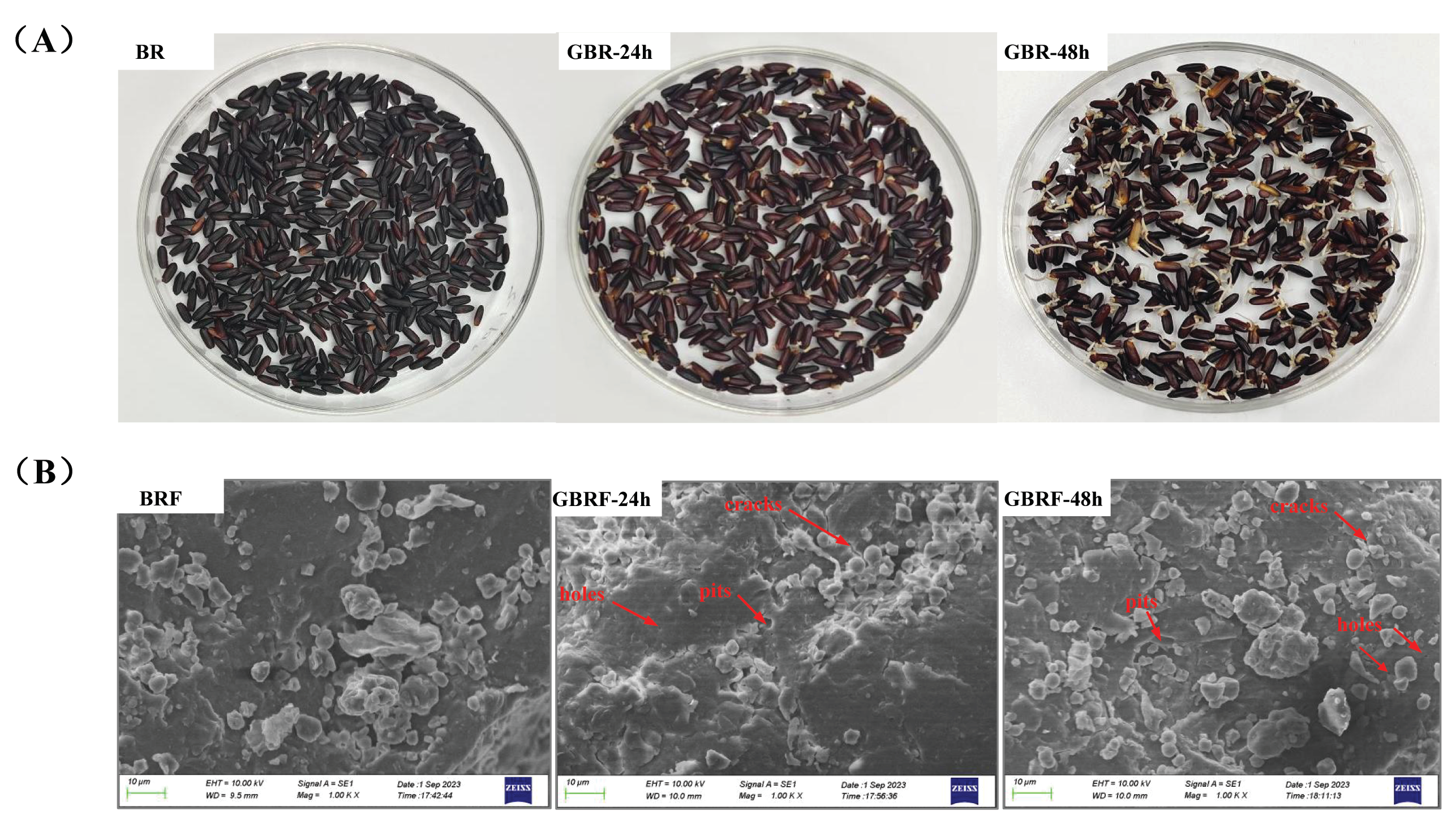
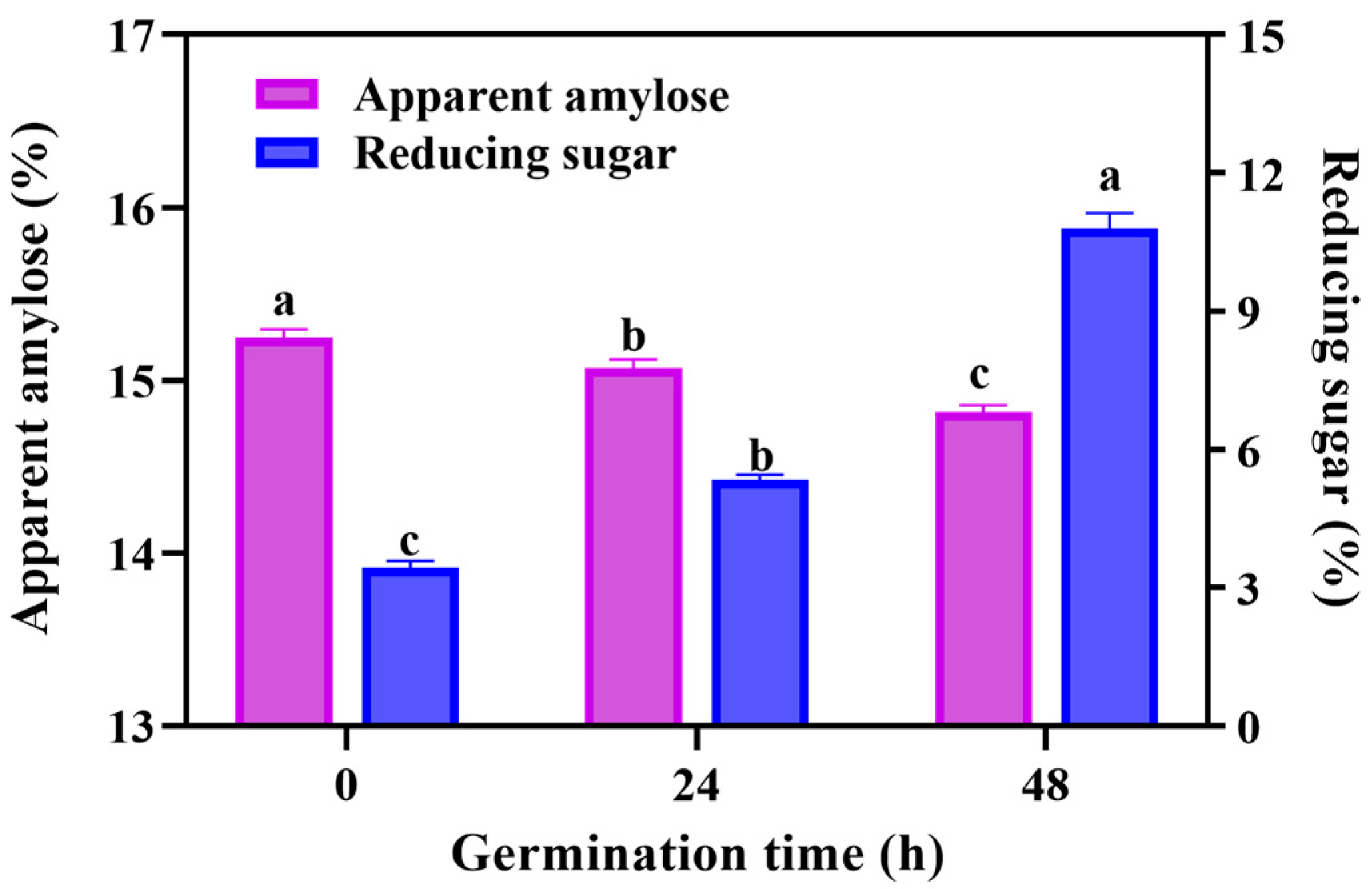
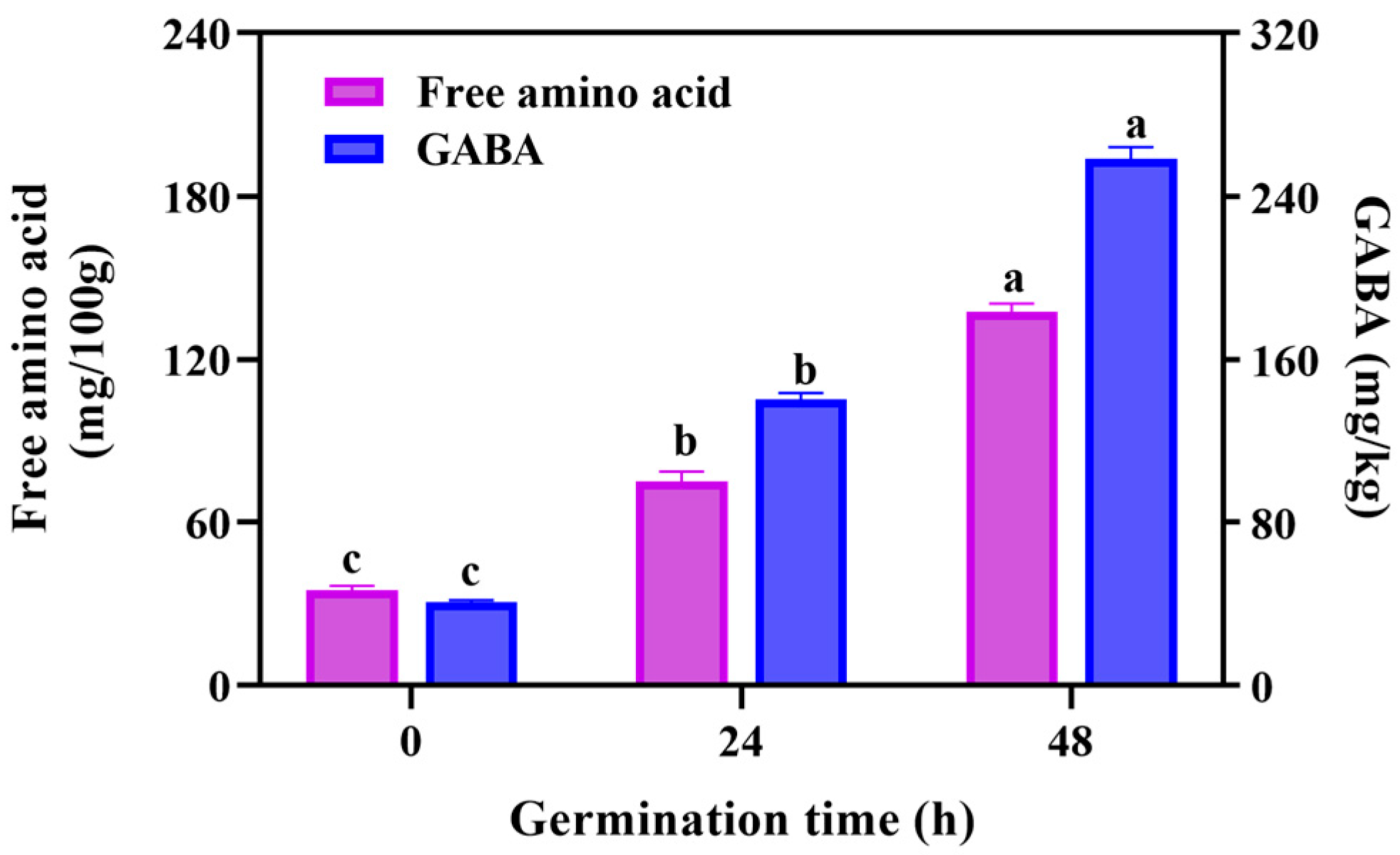
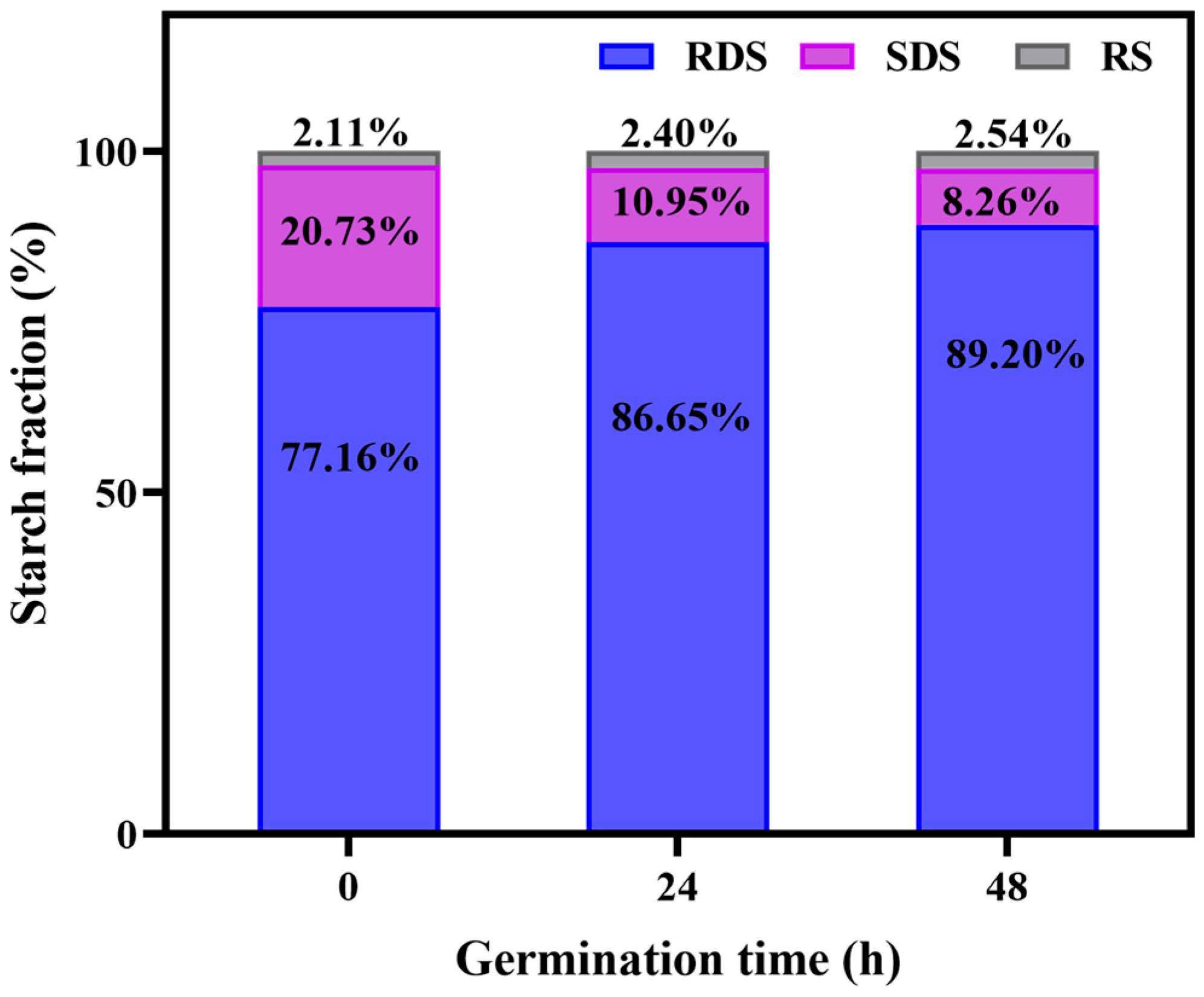
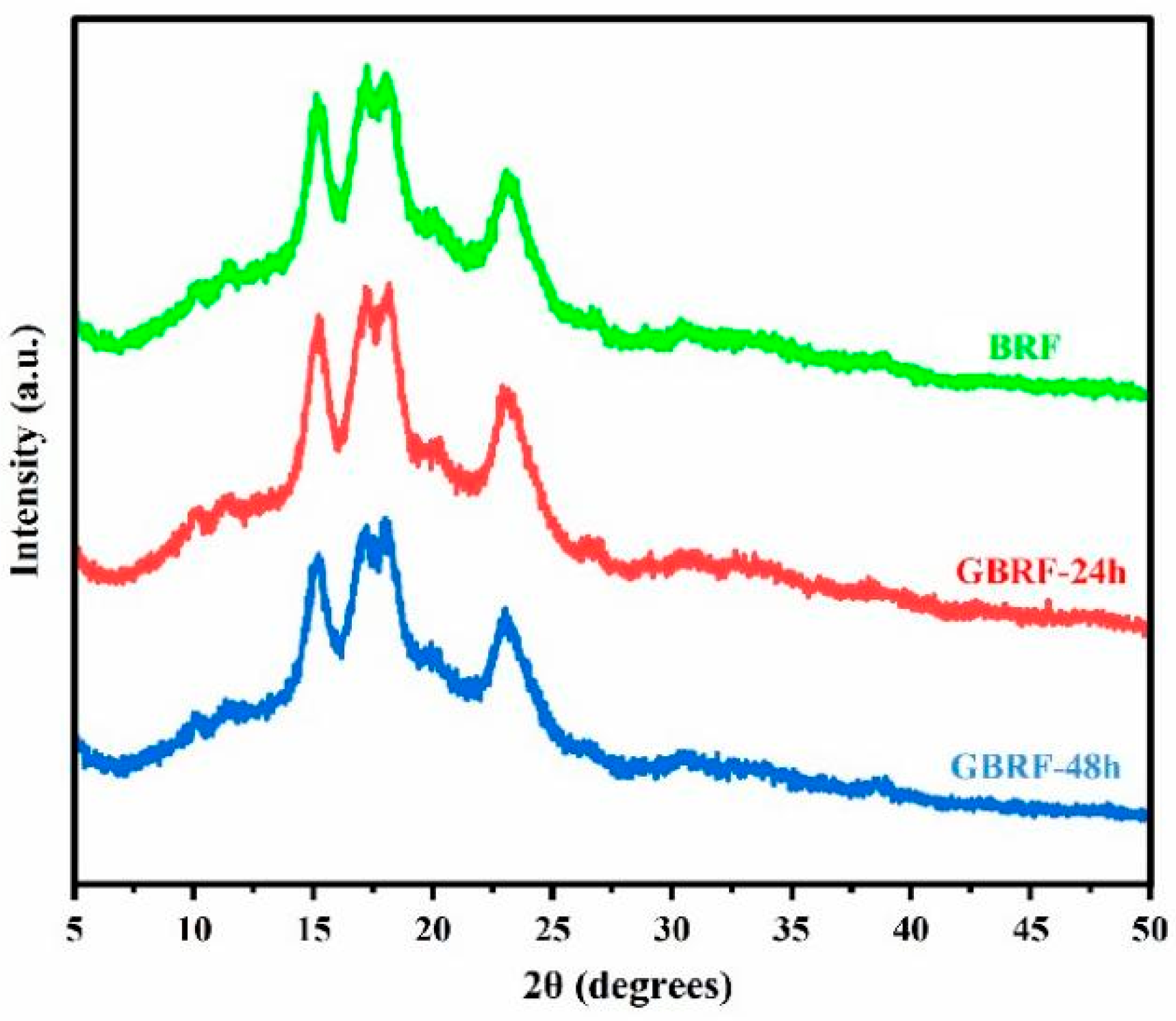

| Sample | Na (mg/kg) | Mg (mg/kg) | K (mg/kg) | Ca (mg/kg) | Fe (mg/kg) | Cu (mg/kg) | Zn (mg/kg) |
|---|---|---|---|---|---|---|---|
| BRF | 12.33 ± 0.71 c | 1231.07 ± 43.72 b | 4044.93 ± 93.16 a | 45.90 ± 4.25 c | 11.83 ± 0.65 a | 0.28 ± 0.03 b | 13.77 ± 0.85 b |
| GBRF-24 h | 29.13 ± 1.65 b | 1435.63 ± 69.75 a | 3727.83 ± 77.64 b | 81.30 ± 6.83 b | 13.03 ± 0.76 a | 0.38 ± 0.01 a | 17.37 ± 1.00 a |
| GBRF-48 h | 32.93 ± 0.65 a | 1272.07 ± 73.39 b | 3148.07 ± 63.57 c | 91.47 ± 2.51 a | 11.90 ± 0.89 a | 0.41 ± 0.01 a | 14.60 ± 0.56 b |
| Sample | α-Amylase Activities (U/g) | WAI (g/g) | WSI (%) |
|---|---|---|---|
| BRF | 1.02 ± 0.01 c | 2.58 ± 0.02 a | 1.61 ± 0.03 c |
| GBRF-24 h | 2.05 ± 0.06 b | 2.39 ± 0.03 b | 2.25 ± 0.06 b |
| GBRF-48 h | 4.46 ± 0.02 a | 2.29 ± 0.03 c | 3.08 ± 0.06 a |
| Sample | To (°C) | Tp (°C) | Tc (°C) | ∆H(J/g) |
|---|---|---|---|---|
| BRF | 80.03 ± 0.27 a | 83.60 ± 0.13 a | 87.80 ± 0.17 a | 10.57 ± 0.09 c |
| GBRF-24 h | 78.67 ± 1.12 a | 83.61 ± 0.10 a | 87.68 ± 0.11 a | 12.27 ± 0.09 a |
| GBRF-48 h | 80.02 ± 0.18 a | 83.49 ± 0.22 a | 87.55 ± 0.08 a | 12.05 ± 0.03 b |
| Sample | Peak Viscosity (cP) | Trough Viscosity (cP) | Breakdown Viscosity (cP) | Final Viscosity (cP) | Setback Viscosity (cP) | Peak Time (min) | Pasting Temperature (°C) |
|---|---|---|---|---|---|---|---|
| BRF | 2932.00 ± 30.15 a | 1810.33 ± 32.56 a | 1121.67 ± 6.51 b | 2601.67 ± 46.26 a | 791.33 ± 14.47 a | 5.80 ± 0.01 a | 85.17 ± 0.06 a |
| GBRF-24 h | 2739.00 ± 44.51 b | 1559.33 ± 38.76 b | 1179.67 ± 13.05 a | 2320.00 ± 46.51 b | 760.67 ± 14.29 a | 5.71 ± 0.01 b | 85.30 ± 0.10 a |
| GBRF-48 h | 2037.67 ± 39.02 c | 942.67 ± 25.48 c | 1095.00 ± 20.07 b | 1519.67 ± 54.72 c | 577.00 ± 32.08 b | 5.28 ± 0.02 c | 84.31 ± 0.04 b |
Disclaimer/Publisher’s Note: The statements, opinions and data contained in all publications are solely those of the individual author(s) and contributor(s) and not of MDPI and/or the editor(s). MDPI and/or the editor(s) disclaim responsibility for any injury to people or property resulting from any ideas, methods, instructions or products referred to in the content. |
© 2025 by the authors. Licensee MDPI, Basel, Switzerland. This article is an open access article distributed under the terms and conditions of the Creative Commons Attribution (CC BY) license (https://creativecommons.org/licenses/by/4.0/).
Share and Cite
Zhu, L.; Xie, Q.; Qin, D.; He, Y.; Yuan, H.; Mao, Y.; Pan, Z.; Li, G.; Xia, X. Germination-Induced Biofortification: Improving Nutritional Efficacy, Physicochemical Properties, and In Vitro Digestibility of Black Rice Flour. Foods 2025, 14, 2912. https://doi.org/10.3390/foods14162912
Zhu L, Xie Q, Qin D, He Y, Yuan H, Mao Y, Pan Z, Li G, Xia X. Germination-Induced Biofortification: Improving Nutritional Efficacy, Physicochemical Properties, and In Vitro Digestibility of Black Rice Flour. Foods. 2025; 14(16):2912. https://doi.org/10.3390/foods14162912
Chicago/Turabian StyleZhu, Lingfeng, Qiutao Xie, Dandan Qin, Yi He, Hongyan Yuan, Yingchao Mao, Zhaoping Pan, Gaoyang Li, and Xinxin Xia. 2025. "Germination-Induced Biofortification: Improving Nutritional Efficacy, Physicochemical Properties, and In Vitro Digestibility of Black Rice Flour" Foods 14, no. 16: 2912. https://doi.org/10.3390/foods14162912
APA StyleZhu, L., Xie, Q., Qin, D., He, Y., Yuan, H., Mao, Y., Pan, Z., Li, G., & Xia, X. (2025). Germination-Induced Biofortification: Improving Nutritional Efficacy, Physicochemical Properties, and In Vitro Digestibility of Black Rice Flour. Foods, 14(16), 2912. https://doi.org/10.3390/foods14162912




